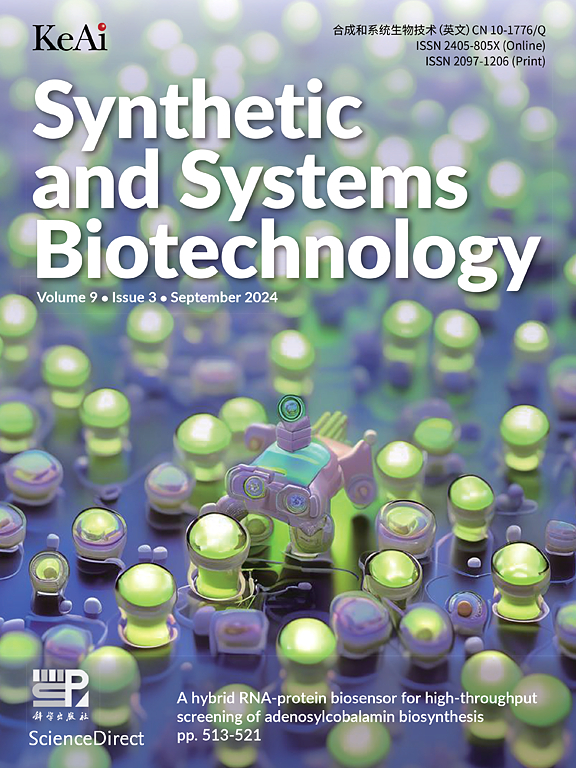A new paradigm for the regulation of A40926B0 biosynthesis
IF 4.4
2区 生物学
Q1 BIOTECHNOLOGY & APPLIED MICROBIOLOGY
引用次数: 0
Abstract
Dalbavancin is a novel glycopeptide antibiotic with activity against a broad range of Gram-positive bacteria, including methicillin-resistant Staphylococcus aureus (MRSA). A40926B0 is the direct precursor of dalbavancin, but the regulatory mechanisms underlying its biosynthesis are not well understood. Additionally, the presence of seven homologs leads to significant metabolic burden, affecting both production and purity of A40926B0. To further reveal the transcriptional regulatory mechanism of A40926B0 biosynthesis in N. gerenzanensis L70, this study employed multiple strategies to explore the regulatory network of its biosynthesis from both intracluster and extracluster aspects. WblA regulates gene expression within and outside the biosynthetic gene cluster (BGC), impacting multiple biosynthetic pathways, and Dbv3, a key regulator in the A40926B0 cluster, positively influences biosynthesis. Using a bottom-up (DNA to protein) regulator mining strategy with the key intra-cluster regulator Dbv3, it was determined that GlnR is also involved in the regulation of secondary metabolism, while BkdR regulates precursor supply. By constructing the combination of GlnR, BkdR and Dbv3 together with the WblA deletion, the regulatory network of A40926B0 was reconstructed, resulting in a 92 % improvement in purity of A40926B0. The objective of this study is to elucidate the regulatory mechanisms governing A40926B0 biosynthesis by constructing a comprehensive, multidimensional model of its regulatory network. The findings of this study serve to enhance our comprehension of A40926B0 biosynthesis and furnish insights into broader strategies for enhancing the production of other natural products and secondary metabolites in industrial microbiology.

A40926B0生物合成调控的新范式
Dalbavancin是一种新型的糖肽抗生素,具有抗多种革兰氏阳性细菌的活性,包括耐甲氧西林金黄色葡萄球菌(MRSA)。A40926B0是dalbavancin的直接前体,但其生物合成的调控机制尚不清楚。此外,7个同源物的存在导致了显著的代谢负担,影响了A40926B0的产量和纯度。为了进一步揭示gerenzanensis L70中A40926B0生物合成的转录调控机制,本研究采用多种策略从簇内和簇外两个方面探索其生物合成的调控网络。WblA调节生物合成基因簇(BGC)内外的基因表达,影响多种生物合成途径,而A40926B0簇中的关键调控因子Dbv3对生物合成有积极影响。使用自下而上(DNA到蛋白质)的调控因子挖掘策略和关键的簇内调控因子Dbv3,确定GlnR也参与调控次级代谢,而BkdR调节前体供应。通过构建GlnR、BkdR和Dbv3与WblA缺失的组合,重构了A40926B0的调控网络,使A40926B0纯度提高了92%。本研究旨在通过构建A40926B0调控网络的综合、多维模型,阐明A40926B0生物合成的调控机制。该研究结果有助于加深我们对A40926B0生物合成的理解,并为提高工业微生物学中其他天然产物和次生代谢产物的生产提供更广泛的策略。
本文章由计算机程序翻译,如有差异,请以英文原文为准。
求助全文
约1分钟内获得全文
求助全文
来源期刊

Synthetic and Systems Biotechnology
BIOTECHNOLOGY & APPLIED MICROBIOLOGY-
CiteScore
6.90
自引率
12.50%
发文量
90
审稿时长
67 days
期刊介绍:
Synthetic and Systems Biotechnology aims to promote the communication of original research in synthetic and systems biology, with strong emphasis on applications towards biotechnology. This journal is a quarterly peer-reviewed journal led by Editor-in-Chief Lixin Zhang. The journal publishes high-quality research; focusing on integrative approaches to enable the understanding and design of biological systems, and research to develop the application of systems and synthetic biology to natural systems. This journal will publish Articles, Short notes, Methods, Mini Reviews, Commentary and Conference reviews.
 求助内容:
求助内容: 应助结果提醒方式:
应助结果提醒方式:


